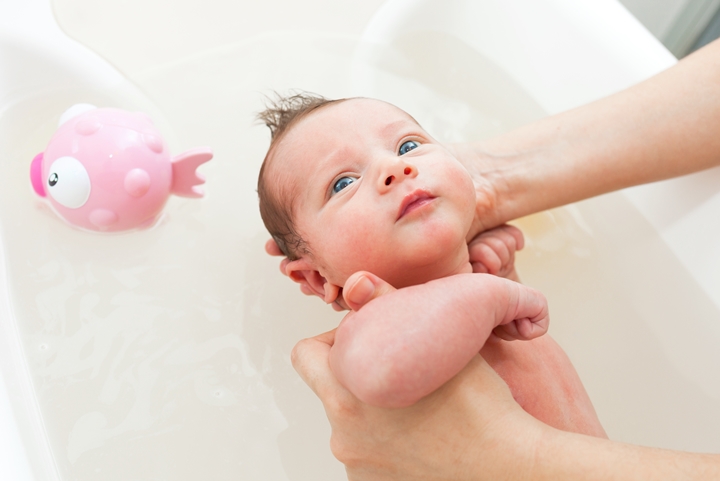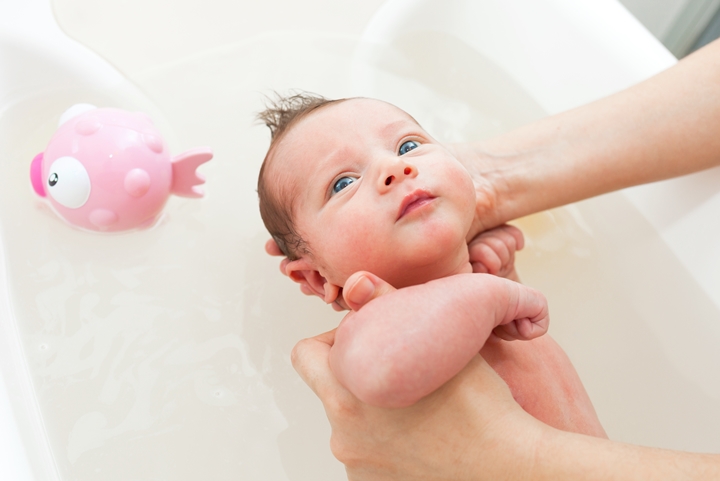
Learning how to bath your newborn baby safely is a very important aspect of newborn care. Newborn bathing can be difficult for new parents who have just learnt about holding their baby for the first time. Dealing with a wiggling and slippery baby can be a daunting challenge! In this part 4 of guide to newborn care series, we are going to give you some simple tips to make newborn bathing a safe, happy and enjoyable experience for both parent and child.
When Does Newborn Bathing Start?
The American Academy of Paediatrics suggests that you shouldn’t give you child an immersive bath until their umbilical cord stump falls off, which can take three weeks (McInerny TK, 2009). Until then, you should be using sponge baths to keep your child clean.
To Perform a Sponge Bath
- Choose a clean flat surface (changing table, counter) in a warm room.
- Fill a sink or bowl with warm water, checking the temperature is comfortable against your inner wrist. Alternatively, use a thermometer to check the water, aiming for 38 degrees Celsius (100 degrees Fahrenheit).
- Use a washcloth or cotton ball to clean your child, starting at the top and moving down.
- Clean your child’s eyes, nose, ears and mouth with warm water. Wipe your baby’s closed eyes from the inside out. Use a fresh cotton ball for each eye. When cleaning the ears, only use cotton wool on the outside and don’t let any water get inside the ears.
- Create a lather with baby soap and wash the rest of their head. Use fresh cotton balls and towels as necessary.
- Move down the body, paying special attention to crevices around their neck and under their arms. Also ensure that the genital area is well cleaned.
- Dry your baby then dress them again.
After the umbilical cord has detached, you can start bathing your child.
_______________
Read More:
Newborn Baby Skin Care Tips for First Time Mums
First Month Survival Tips for New Dad
Guide to Handling Colicky Baby for New Mums
4 Effective Ways to Bond with Your Baby
_______________
Newborn Bathing
You should choose a good time to bath your newborn. Don’t do it when they are hungry, tired or have just been fed. Prepare the area before hand and make sure that:
- The room is warm
- You have a clean tub or washbowl ready
- You have two clean towels, a clean nappy, clean clothes and cotton wool ready
To perform the bath:
- The tub should be filled with water to a height of between 5 to 8 centimetres (2-3 inches). Avoid using any soaps or oils in the water until your baby is more than a month old.
- Check the temperature of the water on your wrist, ensuring that the water is well-mixed. You can also use a thermometer to check the temperature. Ideally the temperature should be around 38 degrees Celsius (100 degrees Fahrenheit).
- Before placing your newborn into the bath, clean their face using the same procedure as you would for a sponge bath
- Wash their hair while supporting them over the bath, then dry their head. If they have a dirty head or are developing cradle cap, you may need to use a drop of baby shampoo while doing this.
- Slowly lower your baby into the bath, supporting their head and neck with one hand and your forearm. Keep your arm under your newborn’s back, grasping your baby firmly under their armpits.
- Keeping your baby’s head out of the water, clean their body with your other hand. You may find a cup useful for pouring water over their body. Pay special attention to the crevices in their skin.
- Never leave your baby alone in the bath during the entire process.
- Lift them out and dry them using a towel. Now is a great time to give them a massage or long cuddle!
How Often Should You Bath Your Newborn?
It’s important to understand that you don’t need to give your newborn baby an immersive bath everyday. Most newborns will only need to have a bath 2-3 times a week, but they should receive a “top and tail” clean everyday. The top and tail clean is an important part of newborn care that involves cleaning their bottom, face, neck and hands. It can be done in the same manner as a sponge bath.
When is the Best Time for Newborn Bathing?
That really depends upon your schedule and when your baby seems most relaxed. Placing an already stressed newborn into a bath is rarely a good idea. Some parents find that incorporating a bath into a newborn’s night time ritual actually helps them to calm down before bed. Avoid bathing your newborn immediately after they have eaten.
What is the Best Baby Tub for Newborn Care?
There are a wide range of baby tubs available, specially designed for newborns. Some parents choose freestanding tubs made from hard plastic while others find inflatable tubs more convenient. Many parents simply wash their newborn in the bathroom sink! There is no difference in the safety performance of various baby tubs, it really comes down to which type you find convenient.
Sources
Mayoclinic.org,. (2015). Baby bath basics: A parent’s guide – Mayo Clinic. Retrieved 12 July 2015, from mayoclinic.org/healthy-lifestyle/infant-and-toddler-health/in-depth/healthy-baby/art-20044438
McInerny TK, et al. American Academy of Pediatrics Textbook of Pediatric Care. Elk Grove Village, Ill.: American Academy of Pediatrics; 2009:843.
Nhs.uk,. (2015). Washing and bathing your baby – Pregnancy and baby guide – NHS Choices. Retrieved 12 July 2015, from nhs.uk/conditions/pregnancy-and-baby/pages/washing-your-baby.aspx#close
{{cta(‘ceac604f-5007-4fb2-9b20-3629af4173e8’)}}


